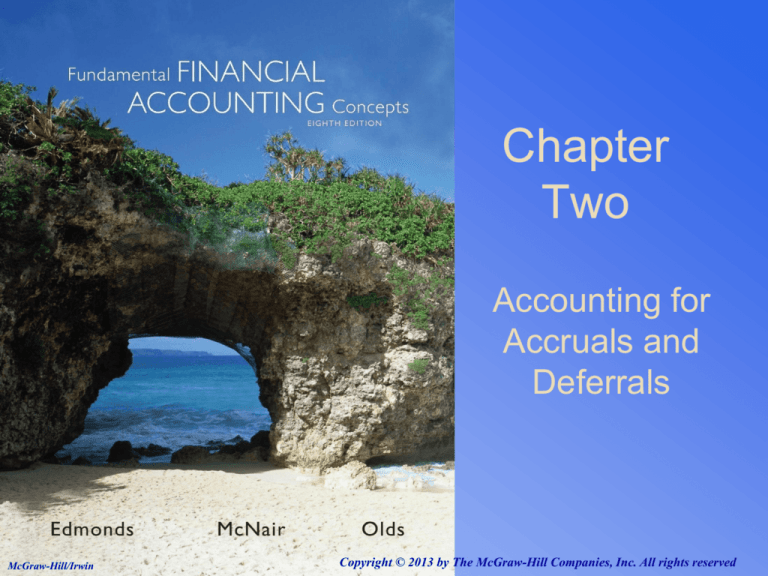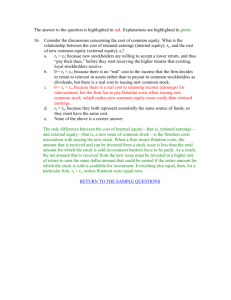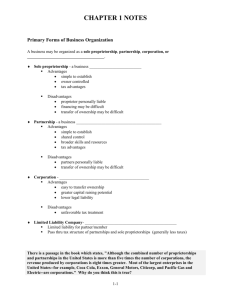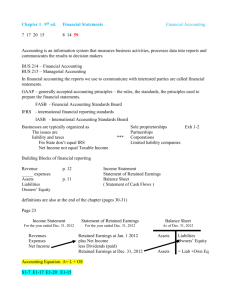
Chapter
Two
Accounting for
Accruals and
Deferrals
McGraw-Hill/Irwin
Copyright © 2013 by The McGraw-Hill Companies, Inc. All rights reserved
Cash Basis vs.
Accrual Accounting
Recognition
Realization
Formally recording
an economic
item or event in the
financial statements
Collecting cash,
generally from the
sale of products or
services
2-1
Types of Transactions
The described transactions can be
classified into one of four categories:
Asset
source
Asset
use
Increase
assets,
increase
claims on
assets
Decrease
assets,
decrease
claims on
assets
Asset
exchange
Increase
one asset,
decrease
another
asset
Claims
exchange
Increase one
claims
account,
decrease
another.
2-2
Event 1: Cato Consultants was started on January 1, 2013,
when it acquired $5,000 cash by issuing common stock.
1. Increase assets (Cash).
2. Increase stockholders’
equity (Common Stock).
Assets
Cash
5,000
+
+
=
Supplies
n/a
=
=
Liab.
+
n/a
+
+
Stockholders' Equity
Common
Retained
Stock
+ Earnings
5,000 +
n/a
Asset Source
Transaction
Revenue - Expenses
n/a
n/a
=
=
Net
Income
n/a
Cash Flow
5,000 FA
2-3
Event 2: During 2013, Cato Consultants provided $84,000
of consulting services to its clients but no cash has been
collected.
1. Increase assets (accounts
receivable).
2. Increase stockholders’
equity (retained earnings).
Assets
= Liab. +
Stockholders' Equity
Accounts
Salaries
Common
Retained
Cash + Receivable = Payable + Stock + Earnings
+
+
+
n/a
84,000 =
n/a
n/a
84,000
Asset Source
Transaction
Revenue
- Expenses = Net Income
84,000 n/a
=
84,000
Cash Flow
n/a
2-4
Event 3: Cato collected $60,000 cash from customers
in partial settlement of its accounts receivable.
1. Increase assets (cash).
2. Decrease assets
(accounts receivable).
Assets
= Liab. +
Stockholders' Equity
Accounts
Salaries
Common
Retained
Cash + Receivable = Payable + Stock + Earnings
+
+
60,000 +
(60,000) =
n/a
n/a
n/a
Asset
Exchange
Transaction
Revenue - Expenses =
n/a
n/a
=
Net
Income
n/a
Cash Flow
60,000 OA
2-5
Event 4: Cato paid the instructor $10,000 cash for
teaching training courses (salary expense).
1. Decrease cash (assets).
2. Decrease stockholders’
equity (retained
earnings).
Assets
=
Accounts
Cash
+ Receivable =
=
(10,000) +
n/a
Liab.
n/a
Stockholders' Equity
Common
Retained
+ Stock + Earnings
+ n/a
+
(10,000)
Asset Use
Transaction
+
Revenue - Expenses =
n/a
10,000 =
Net Income
(10,000)
Cash Flow
(10,000) OA
2-6
Event 5: Cato paid $2,000 for advertising
costs. The advertisements appeared in 2013.
1. Decrease assets (cash).
2. Decrease stockholders’
equity (retained
earnings).
Assets
=
Accounts
Cash
+ Receivable =
=
(2,000) +
n/a
Liab.
n/a
Stockholders' Equity
Common
Retained
+ Stock + Earnings
+ n/a
+
(2,000)
Asset Use
Transaction
+
Revenue - Expenses =
n/a
2,000 =
Net Income
(2,000)
Cash Flow
(2,000) OA
2-7
Event 6: Cato signed contracts for $42,000 of
consulting services to be performed in 2014.
Not recognized
in the 2013
financial
statements
Assets
Cash
n/a
+
+
=
Prepaid
Rent
n/a
=
=
Liab.
+
n/a
+
+
Stockholders' Equity
Common
Stock
n/a
+
+
Retained
Earnings
n/a
Revenue
n/a
- Expenses
n/a
=
=
Net Income
n/a
Cash Flow
n/a
2-8
Event 7: At the end of 2013, Cato recorded accrued salary
expense of $6,000 (the salary expense is for courses the
instructor taught in 2013 that Cato will pay cash for in 2014).
1. Increase liabilities
(salaries payable).
Claims
Exchange
Transaction
2. Decrease stockholders’
equity (retained
earnings).
Assets
=
Cash
n/a
=
=
Liab.
Salaries
Payable
6,000
+
+
+
Stockholders' Equity
Common
Stock
n/a
+
+
Retained
Earnings
(6,000)
Revenue
n/a
-
Expenses
6,000
=
=
Net Income
(6,000)
Cash Flow
n/a
2-9
Vertical
Statements
Model
2- 10
Comparing Cash Flow from Operating
Activities with Net Income
2-11
The Closing Process
Transfers net income
(or loss) and dividends
to Retained Earnings.
Establishes zero
balances in all
revenue, expense, and
dividend accounts.
2-12
Temporary and Permanent
Accounts
Assets
Temporary accounts
track financial
results for a limited
period of time.
Liabilities
Permanent
Accounts
Equity
Temporary
Accounts
Dividends
Expenses
Revenues
Permanent accounts
track financial
results from year to
year.
2-13
Steps in an Accounting Cycle
Record
Transactions
Close Nominal
Accounts
Adjust
Accounts
Prepare
Statements
2-14
Matching Concept
Cash basis accounting can
distort the measurement of net
income because it sometimes
fails to properly match
revenues with expenses.
The problem is that cash is not
always received or paid in the
period when the revenue is
earned or when the expense is
incurred.
The objective of accrual accounting is to improve matching of revenues
with expenses.
2-15
The Conservatism Principle
When faced with a recognition
dilemma, conservatism guides
accountants to select the
alternative that produces the
lowest amount of net income.
2-16
Corporate Governance
Corporate governance is the set of
relationships between the board of
directors, management, shareholders,
auditors, and other stakeholders that
determines how a company is operated.
2-17
Importance of Ethics
• The accountant’s role
requires trust and credibility.
• Accounting information is
worthless if the accountant
is not trustworthy.
• Therefore, the accounting
profession requires high
ethical standards.
2-18
AICPA Code of Professional
Conduct
Includes articles requiring CPAs to
• Exercise sensitive professional and moral
judgments.
• Act in a way to serve the public interest.
• Perform with the highest sense of integrity.
• Be objective and independent, in fact and
appearance.
• Exercise due care.
2-19
Sarbanes-Oxley (SOX) Act
• Prompted by the audit failures of Enron,
WorldCom, and others
• Key provisions:
– Created the Public Company Accounting
Oversight Board (PCAOB)
– Requires management to certify financial
statements
– Imposes harsh penalties on management for
violations
2-20
The Fraud Triangle
Opportunity
Key to protecting
yourself and your
company: personal
integrity.
Pressure
Rationalization
2-21
Estimating Straight-Line Depreciation
Asset cost – Salvage Value
Useful Life
($43,000 - $3,000)
4 years
=
= Depreciation
$10,000 per year
The asset account, Forklift, is not decreased directly as a
result of depreciation. Instead, the asset reduction is recorded
in a contra asset account called Accumulated Depreciation.
Assets
Forklift
n/a
=
Accumulated
+ Deprec.
=
+ $
(10,000) =
Liab.
n/a
+
Stockholders' Equity
Common
Retained
+ Stock + Earnings
+
+ $ (10,000)
Revenue - Expenses
=
n/a 10,000 =
Net Income
(10,000)
Cash Flow
n/a
2-22
Calculating Interest
1. Increase liabilities
(Interest Payable).
2. Decrease stockholders’
equity (Retained Earnings).
Assets
Cash
n/a
+
+
=
Equipment
n/a
=
=
Liab.
+
Interest
Payable
+
$
275 +
Stockholders' Equity
Common
Retained
Stock
+
Earnings
+ $
(275)
Claims
Exchange Event
Revenue - Expenses
=
n/a
275 =
Net Income
(275)
Cash Flow
n/a
2-23
End of Chapter Two
2-24











